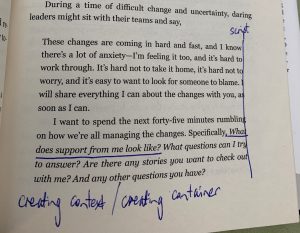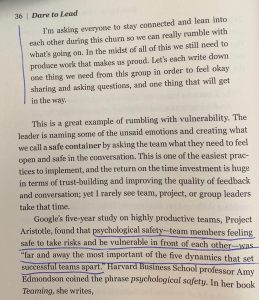I’m really enjoying “Dare to Lead” by Brené Brown.
I’m grateful that she’s using research to validate what I’ve spent the last 20 years doing – finding out who I am, leaning into my fears, and exposing my heart.
She’s my translator, allowing me to translate concepts and tools from the personal growth movement to the corporate world. Jargon, re-framing, context, case studies, studies studies….allowing me to speak to managers, executives and CEO’s in a way they can hear it….in a language that speaks to the bottom-line outcomes they are seeking.
Below are some of my favorite thoughts and quotes as I read through the book. I consider it a primer on how to bring personal growth into the corporate world.
- The top behaviors and cultural issues getting in our way:
- We avoid tough conversations, including giving honest, productive feedback.
- (lack of) acknowledging and addressing the fears and feelings that show up during change and upheaval.
- Diminishing trust caused by a lack of connection and empathy. (“Daring leaders must care for and be connected to the people they lead.“)
- Not enough people are taking smart risks or creating and sharing bold ideas.
- Too much shame and blame, not enough accountability and learning.
- “….we haven’t made great progress in developing these skills in leaders, because we don’t dig into the humanity of this work-it’s too messy. It’s much easier to talk about what we want and need than it is to talk about the fears, feelings, and scarcity that get in the way of achieving…”. “…we don’t have the courage for real talk about courage.“
- “And if you want to call these “soft skills” after you’ve tried putting them into practice-go for it. I dare you.”
- “Vulnerability: the emotion that we experience during times of uncertainty, risk, and emotional exposure.” “Across all of our data there’s not a shred of empirical evidence that vulnerability is weakness.” “…without vulnerability there is no creativity or innovation…because there is no innovation without failure.”
- “A rumble is a discussion, conversation, or meeting defined by a commitment to lean into vulnerability, to stay curious and generous, to stick with the messy middle of problem identification and solving, to take a break and circle back when necessary, to be fearless in owning our parts and…to listen with the same passion with which we want to be heard.”
- “Our ability to be daring leaders will never be greater than our capacity for vulnerability. Once we start to build vulnerability skills, we can start to develop the other skill sets.” “The true underlying obstacle to brave leadership is how we respond to fear.” “The real barrier…is our armor – the thoughts, emotions, and behaviors that we use to protect ourselves when we aren’t willing and able to rumble with vulnerability.”
- “Who we are is how we lead”
- “Leaders…must create and hold spaces that rise to a higher standard of behavior than what we experience in the news, on TV, and in the streets. And for many, the culture at work may even need to be better than what they experience in their own home. Sometimes leadership strategies make us better partners and parents.”
- Armor: “(allow them to) take off the crushing weight of their armor, hang it on a rack, and open their heart to truly being seen.” “You can’t fully grow and contribute behind armor. It takes a massive amount of energy just to carry it around-sometimes it takes all of our energy.”
“We’ve paid for self-protection by sealing off our heart from everyone, and from everything – not just hurt, but love.” - “When our organization rewards armoring behaviors like blaming, shaming, cynicism, perfectionism, and emotional stoicism, we can’t expect innovative work.“
- “Daring is saying ‘I know I will eventually fail, and I’m sill all in.” “”It’s having the courage to show up when you can’t control the outcome.”
- “Myth #3: I can go it alone.” “We are hardwired for connection. From our mirror neurons to language, we are a social species. In the absence of authentic connection, we suffer.” “We don’t derive strength from our rugged individualism, but rather from our collective ability to pan, communicate, and work together.”
- “Trust: a slow-building, iterative, and layered process that happens over time.“
- Creating a safe container for a group rumble:


- Behaviors that inhibit good rumbling: judgment, unsolicited advice giving, interrupting, and sharing outside the team meeting. Encouraging behaviors: listening, staying curious, being honest, and keeping confidence.
Facebook Comments
